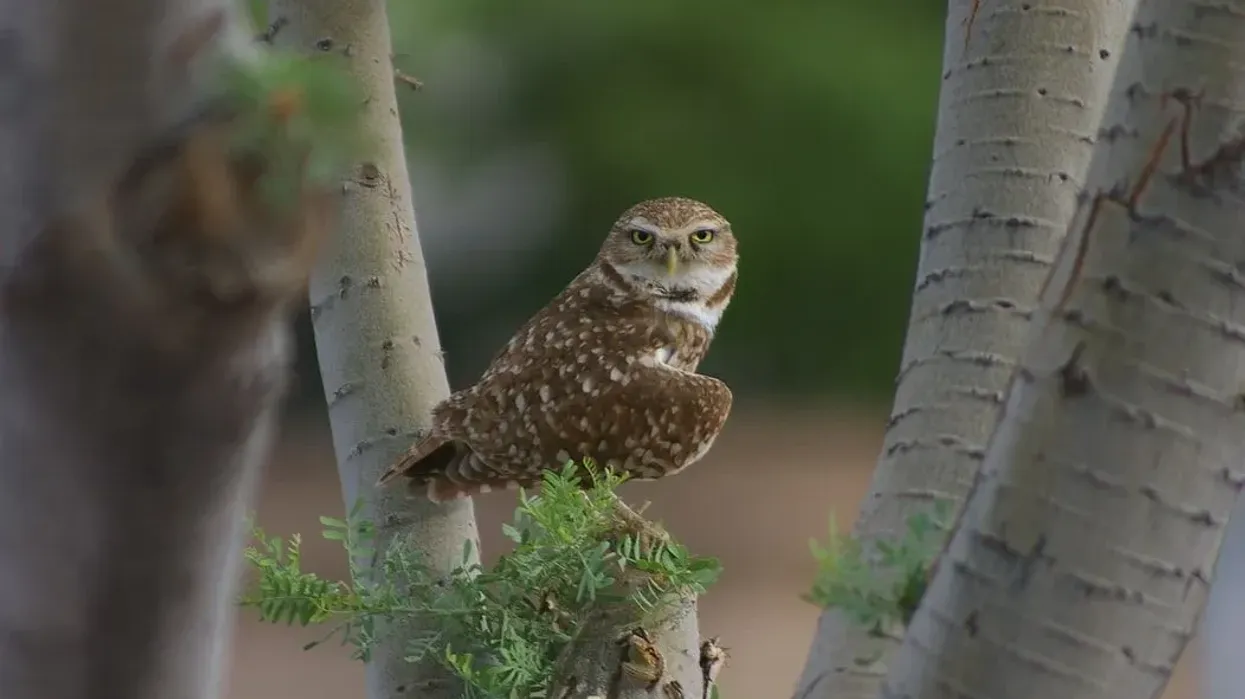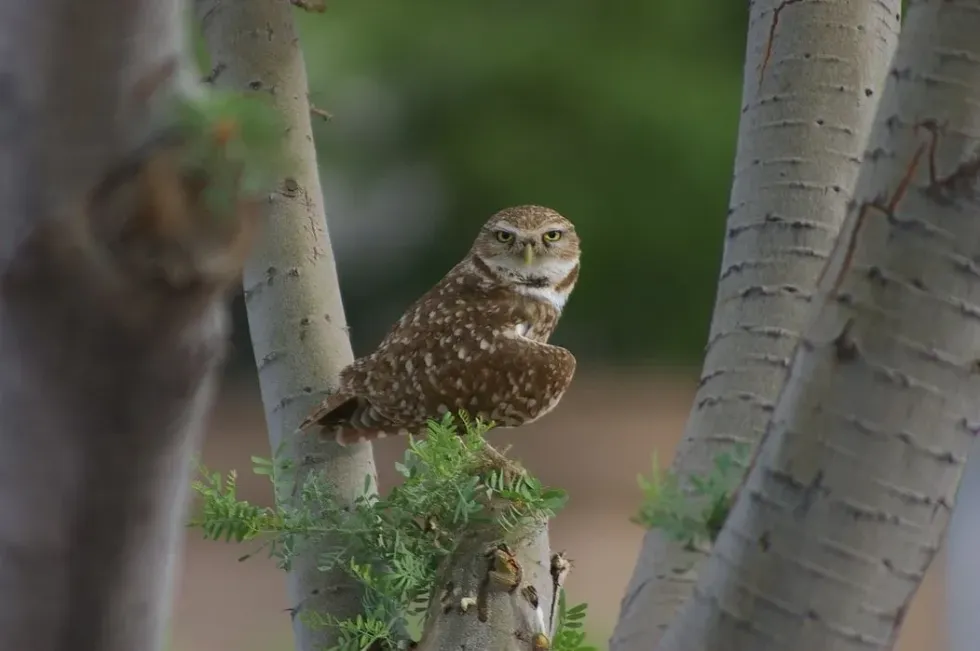Burrowing owls are a small species of owls which prefer terrestrial living. As the name suggests, they live on the ground and in burrows.
They rarely live on trees and find animal-made burrows to build their nest. Contrary to other species of owls which are active only during the night, burrowing owls are active during the day as well as the night.
The only other owl known to be active during the day is the snowy owl. Burrowing owls avoid the intense heat of mid-day and are usually active during morning, evening, and nighttime.
They can be found all over North, South, and Central America. If you want to learn even more fascinating stuff about the burrowing owl, read on.
If you like reading about birds, then you should also read about tawny owl and barn owl.
Burrowing Owl Interesting Facts
What type of animal is a burrowing owl?
A burrowing owl is a migratory bird.
What class of animal does a burrowing owl belong to?
Burrowing owls belong to the class of animals of Aves.
How many burrowing owls are there in the world?
According to Partners in Flight, a global breeding population of 2 million has been estimated of this specie.
Where does a burrowing owl live?
Burrowing owl habitat can be found in North American grassland regions of southern Alberta, Saskatchewan, and Manitoba. They can be found in Mexico, Central America, and South America, with subspecies in Florida and the Caribbean Islands. During the breeding season, they can be found south of western and mid-western states.
What is a Burrowing owl's habitat?
Burrowing owls live mostly on the ground in grasslands, deserts, farmlands, prairies, and savannahs. They usually don't dig their own burrows and live in burrows made by prairie dogs and ground squirrels.
Who do burrowing owls live with?
Burrowing owls live in loose colonies with their own kind in animal-made burrows. The adult members of the family take turns to guard the entrance of the burrows while other adult members have gone hunting.
How long does a Burrowing Owl live?
Burrowing owls can survive almost nine years in the wild and as long as ten years in captivity.
How do they reproduce?
The burrowing owl nesting season includes early spring and summer, usually in late March and April. Burrowing owls make their nest in open areas in burrows made by ground squirrels or prairie dogs, instead of nesting in higher trees.
The female lays around 2-12 eggs every one to two days till the clutch is complete. The incubation period of these eggs is 28-30 days.
It takes a burrowing owl almost six weeks to fully fledge, and it becomes sexually mature at the age of one year. These owls are fairly monogamous, but sometimes a male may have two female partners.
What is their conservation status?
They have been classified as Least Concern by the IUCN Red List. Many reasons have led to the number of burrowing owls declining in various states.
The number one cause of this decline is habitat degradation and destruction.
Burrowing owl nests are being destroyed due to a number of factors, including pesticide use, poisoning of prairie dog colonies, and automobile collisions. They can sometimes be found injured due to human interference in their habitat.
In case you find an injured burrowing owl, place a towel or sheet over its head and keep it in a cardboard box before you take them to the nearest veterinarian.
They have been categorized as different conservation concerns in different regions, including threatened in Mexico, endangered in Canada, and as a species of concern in California. Burrowing owls have been classified as federally protected by the decree of the Migratory Birds Treaty Act in the countries of the USA, Canada, and Mexico.
Burrowing Owl Fun Facts
What do burrowing owls look like?

They have pale brownish faces with white eyebrows and wide yellow eyes. They have a whitish throat band which is quite distinctive.
Their bill/beak is sandy to yellowish in color. Their feathers are dark brown for females and light brown for males, with dotted round white marks on both genders. They have long legs, which makes them quick in both running and flying, making it easier for them to catch their prey.
How cute are they?
When it comes to cuteness, burrowing owls are one the cutest owls out there. With their small size and round small heads with big yellow eyes, they have been often considered one the cutest birds in both South America and some North American regions.
How do they communicate?
Burrowing owls use a variety of noises to communicate, which include clucking, screaming, and chattering. These birds also make hissing and rattling sound to intimidate predators and alarm them.
They also use the 'head bob' to show excitement and use bill snapping and wing flap to display distress. Adults have been identified to make as many as 13 vocal noises, and the juveniles have been found to make three vocalizations.
These three vocalizations usually consist of calls of defense, distress, and asking for food. The primary sound that they make is a 'coo-coo' during the daytime and a 'co-hoo' during the nighttime.
How big is a burrowing owl?
Burrowing owls are almost 7.5-9.5 in (19-24 cm) in height and have a wingspan of 20-24 in (51-61 cm). They are larger than the average size of an American robin and smaller than that of a crow.
An interesting thing to note about the burrowing owl size is that even though the female birds are heavier, the male birds tend to have longer linear measurements.
How fast can a burrowing owl fly?
Even though they mainly live on the ground in grasslands, farmlands, and burrows made by prairie dogs, they can, contrary to widespread perception, can fly. They often hunt their prey mid-air and are considered to be quick while both are running and flying.
How much does a burrowing owl weigh?
A burrowing owl weighs around 4.5-9 0z (127.5-255 g). The female birds of this species tend to be heavier than the male owls.
What are their male and female names of the species?
Both male and female owls of this particular species have the same name.
What would you call a baby burrowing owl?
The baby burrowing owls are called owlets, just like the baby owls of other species.
What do they eat?
The burrowing owl diet usually includes insects like grasshoppers, dung beetles, and other large insects for food. They are skilled hunters and can easily hunt many small mammals like mice, rats, ground squirrels, bats, gophers, young cottontail rabbits, and other burrowing animals.
Apart from insects and small mammals, these owls also prey on some birds for food like sparrows, and horned larks. Other foods of this species also include amphibians, scorpions, and small reptiles, which are found near their nest and burrows.
Are they dangerous?
Burrowing owls are not dangerous. They often display threats when humans walk by their nest and emit a high-pitched shriek to scare them away but are inherently no danger to humans.
Would they make a good pet?
It is currently illegal to own burrowing owls as pets because they are protected by the Migratory Bird Act.
Did you know...
The brown color of male burrowing owls feathers is lighter than the females because of bleaching due to the sun's rays. Females spend most of their time away from the sun inside burrows, which makes them look brighter.
Although all burrowing owls are considered to be of the same species, there are almost 22 subspecies of burrowing owls across the Americas.
One of the most interesting burrowing owl habits is that they collect manual waste and keep it in and around their nest to attract dung beetles. This is because they are the burrowing owls' favorite foods. This habit also has ecological advantages, which makes these birds important.
The burrowing owl's Adaptations
Burrowing owl adaptations are related to their environment. For example, these owls have developed long legs as they live mainly in open grasslands and have to sprint during hunting.
This adaptation makes them easier for them to catch their prey. One of the more interesting adaptations of burrowing owls is that they (especially the owlets) can mimic the sounds of a rattlesnake to scare away predators.
The call of the burrowing owl
Burrowing owls make a wide range of vocalizations, including 'rasp', 'chuck', and 'chatter'. The main call of this bird, however, includes the soft 'who-who', which is mainly made by the male members of this species. The total calls of adult burrowing owls that have been identified are about 17 in total.
Here at Kidadl, we have carefully created lots of interesting family-friendly animal facts for everyone to discover! Learn more about some other birds including umbrellabird, and the bee-eater.
You can even occupy yourself at home by drawing one on our burrowing owl coloring pages.









